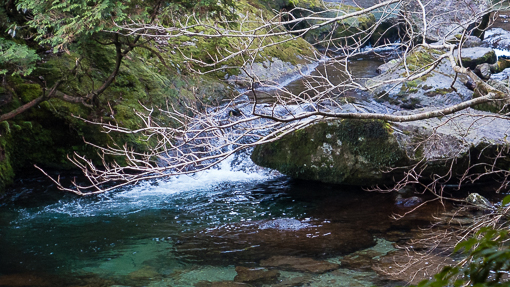Shiratani Unsuikyo was our first hiking destination on the island – it is a ravine – with a pretty name (白谷雲水峡, white valley cloud water ravine). It is one of the three most recommended hikes for the island – probably the top choice.

We took the bus from Miyanoura which climbed the inland mountains. The road was surprisingly well-paved and wide. It must have been upgraded over the years due to the popularity of our destination, tour buses are expected. But there were hardly any cars on the road.

The ravine is part of the Kirishima National Park which offers a network of reasonably well-maintained hiking trails that run along and around the ravine. We picked one that on paper will take two and a half hours roundtrip – from no.1 to no. 13 and back via no. 12 – the longer loop. It took much longer, as we expected, knowing our legs.

Shiratani Unsuikyo can be closed during a heavy rainfall as the rivers can become too dangerous to cross. We were lucky in that it did not rain so there was no wading across the streams (we had to hop across at least two small ones) – the small photos in the notice board above illustrate the difference in volume before and after rain. The streams are indicated with a ” ! “.

It must be spectacular during the rainy season here.

Yakushima is one of the wettest places in Japan (about 10,000 mm of rainfall in a year in the mountainous area).
 It was very pretty here.
It was very pretty here.

Beyond this bridge, the trail was no longer paved and it became steeper. We did not cross at this point as we took the prettier route (according to Wikitravel).

One of the main attractions of Shiratani Unsuikyo is a part of the forest that served as the inspiration for Miyazaki Hayao 宮崎 駿 (Studio Ghibli) – animated film Mononoke Himeもののけ姫 (魔法公主, Princess Mononoke).

There are more than 600 species of mosses on this island and they grew on top of each other forming dense layers on almost any surface.

The lead artist for the film – Princess Mononoke, spent lots of time here working on sketches for the movie’s forests – the sinister-looking roots were spreading and crawling over fallen logs and even living trees.

The altitude is 600m (1969ft) at the entrance and about 900m (2953ft) in the forest of Princess Mononoke.

The fact it did not rain also meant that the rocks were not slippery. Despite having the right footwear, it was still tricky to hop from one moss-covered rock to another.

Along the way, we saw many ancient cedar trees.

Some roots and trunks were so ancient that one can pass through the spaces beneath their roots.

Our turnaround point was the Shiratani hut – “white mountain hut” which is provided as a place where one can camp. We returned using a different path, the Kusugawa trail one that was used by loggers who harvested the trees in the Edo period.
Exhausted but it was good hiking, and made soaking in the hot springs and a multi-course dinner all the more deserving.

